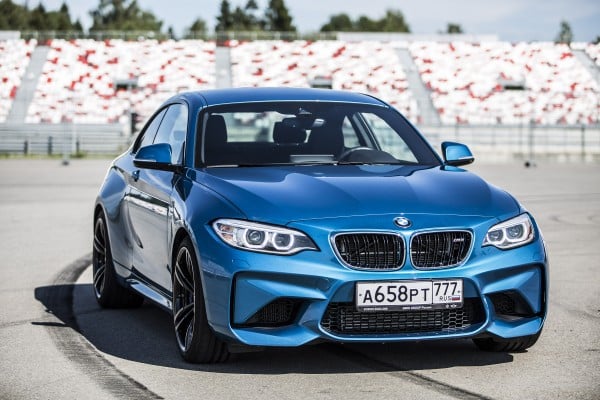Inevitably, when a car enthusiast
decides to dabble in automotive journalism, he’ll be reviewing the cars he’s most interested in driving.
So when BMW offered me to drive its new M2 Coupe for a week, I jumped at the opportunity. I guess all those sensible cars which sane people drive will have to wait a little bit longer.
BMW’s M division, like its counterparts in other German brands, has received some criticism in recent years. Mostly from elitist car reviewers (who, me?) and people who appear to struggle with the fact that time and technology do not stand still. I won’t go into the same old discussion yet again, but the fact is that from 1978 all the way to 2011 all BMW M cars had naturally aspirated engines and there are none left right now. The engine has always been the centerpiece of any BMW, which shouldn’t be surprising since BMW stands for Bavarian Motor Works, and those made by the Motorsport division have always been held in particularly high regard. If BMW M GmbH was a musical band and engines were songs, it would be the Beatles. There’s just so many hits. From straight 6 to V8 and even V12 engines — who can forget the 3.2 liter straight 6 from the E46 M3 or the 618 horsepower 6.1 liter V12 that found its way into the McLaren F1? Hey Jude and Let it be, eat your heart out.
Of course more recent works of Paul McCartney aren’t quite as memorable as the brilliance of the past. For different reasons, mostly tighter regulation for car emissions and the need for less fuel consumption, the modern BMW M engines aren’t as exciting as the old ones either. It’s true and there is no way around it, let’s just state this as a matter of fact so we can get on with how we like the rest of the car. You’ll notice that, in good journalistic fashion, I’ve gotten the bad news out of the way first so we can get on with the many things that do make the M2 a great car. To some hard-headed people, the true BMW M car died when the final E92 M3 left the factory with its great, 8500 RPM capable, naturally aspirated V8. But I’m here to let you know that the latest generation M car is still doing the legend justice.
![]()
The BMW M2 is the entry level M car, as it’s the smallest and least expensive of them all. The range of cars is a bit tricky to understand these days because BMW has adjusted its naming strategy somewhat. The direct predecessor to the M2 is the 1M Coupe from 2011 which was the first turbocharged M car in history. They couldn’t call that one the M1 because the name was taken by the original M1 which was entirely different. These days, all BMW M Coupes have even numbered names so you have the M2, M4 and M6 which have 2 doors. The M3 and M5 have 4 doors. Then you have the X5M and X6M which do both have 4 doors but are SUVs so very different cars altogether. Then there are many BMWs with an M badge which aren’t M cars. Like the M235i or M550d. Those are just more sporty versions of the regular models. It’s a bit of a mess to explain be honest, but what’s in a name anyway.
The M2 also breaks tradition somewhat by using an «N» type engine — it’s basically the same N55 engine as you get in the M235i and other regular BMW models except with a bit more power. All other M cars thus far used an «S» designated engine to indicate a special Motorsport devision engine. The M3/M4 use the S55 engine for example. But both N55 and S55 are very similar 3 liter turbocharged straight 6 engines and I would be lying if I said the M2’s engine seemed particularly different to the M3’s. Most notably though, BMW is the last big manufacturer left, if my memory serves me well, to still use a straight 6 engine rather than a V6. And I applaud them for it, this is one part of the traditional BMW engine design which is still very much alive. The reason why most 6-cylinder cars use a V6 is that it’s a lot easier to fit into an engine bay. A V6 has two rows of three cylinders so it only needs to be about half as long as a straight 6 where you get 6 cylinders in a row. A more square engine block will always be easier to fit into a square engine bay than a very rectangular straight 6. But the straight 6 engine design is inherently balanced while a V6 is not. So it has less frictional losses because it doesn’t require balance shafts and only uses 2 cam shafts rather than 4. All this makes the BMW 6-cylinder engine unbelievably smooth and a pleasure to operate.
As soon as you lower yourself into the driving seat of the new M2, you can tell you’re in a real M car. And even at the slowest of speeds, driving it out of the parking lot, you feel a massive amount of confidence and capability in the suspension and steering. It kind of feels like it looks — like a little body builder of a car. It has a very wide looking stance, protruding wheel arches and an aggressively sculpted front bumper. It looks quite mean actually, especially for such a small car. If the M2 was a bouncer at a night club, you wouldn’t dare to make any ill-considered jokes about its size lest you fancied a trip to the emergency room.
![]()
I will admit that the styling of the car is probably aimed a bit more at the younger generation rather than 50-year olds experiencing a midlife crisis. But to people who know what to look for, there are many clues that this is a seriously high performance automobile. Like the sheer size of the brakes both front and back. I personally just love big brakes. I’m a big brake kind of guy. Not just how they look, but how they feel too. The brakes. Acceleration is all fun and games, but you want to slow down quickly too. To drive a car properly fast you want to feel like you have more brakes than you’ll ever need. The M2 ticks that box very well, and it’s especially worth noting because this is such a big improvement over the old M cars I was speaking of so fondly earlier. The old E46 or E92 M3s for example, they may have had spectacular engines but their standard brakes were decidedly so-so and would not stand up to racetrack use. The youngest generation of M cars now all get seriously big and powerful brakes, a huge leap forwards. There’s even an option to get track-focused brake pads from BMW now, which is completely awesome and much more convenient than using aftermarket (not BMW approved) brake pads.
![]()
The M2 really feels like a car you could very easily take to the racetrack, and then use it for going to the supermarket when you’re done. Its dual-clutch gearbox has a dual personality, with a comfortably lazy side as well as a fast and hard-shifting manic mode. Long gone are the days when the automatic gearbox was boring. Sure, there is still a sweet old-fashioned case to be made that sports cars are more fun with a manual gearbox. But then if you live in a city and want to use the car every day you’d probably like the extra level of comfort that the DKG gearbox brings to the M2. DKG stands for Doppelkupplungsgetriebe in German, if you were wondering. I just love the fact that the German language allows you to add together almost as many words as you like, watching non-German speakers try to pronounce it is always a source of great hilarity. And it’s just a great gearbox as well, obviously. It behaves a bit different in traffic from most automatic gearboxes though, in that it will engage neutral when you come to a complete stop. So you don’t need to keep your foot on the brake if the ground is level. It takes a little while to get used to, but I do like this approach and it makes it feel less like a regular automatic gearbox as a bonus.
In terms of ride comfort, the M2 is decidedly on the firm side. I happen to like a firm suspension myself, but keep in mind that you might catch some flak from your wife or girlfriend in the passenger seat when she tries to put on some lip gloss in the car when you’re already late to a party. It can get a bit bumpy, as it’s still a sports car. Putting the car in «Comfort» mode does help to take the edge of things a bit, just don’t expect it to ride like a 7 series. The upside of the suspension setup is that it feels absolutely wonderful when you point it into a corner with some commitment. The front axle seems almost impossible to unstick, the rear is obviously a bit easier because you can send 370 horsepower and up to 500 Nm of torque through the rear wheels whenever you want to. The active M rear differential will assist you in making pretty big slides or smoky burnouts very easily too. Not that I expect any of my readers to be so childish as to enjoy burning rubber for no good reason, of course, that would be silly.
![]()
Inside the M2, things are sufficiently comfortable but definitely not luxurious. BMW has clearly spent most of the money on making the car fast and great to drive and not so much on making you feel like you’re in a roadgoing version of the Taj Mahal. Sounds about right to me, weight is the enemy of sports cars and I’d rather spend my money on performance rather than the softness of leather any day of the week. It just makes sense for a car like the M2 to focus on what it does best: giving its occupants a very great time indeed. I was almost surprised by just how powerful the engine feels, particularly at lower RPMs. There is clearly a lot of turbo boost available in the middle of the RPM band, also thanks to a temporary overboost function which allows increased pressure from the turbocharger for a limited amount of time. If you floor the car on the highway at 3000RPM in manual gearbox mode, the amount of thrust that is produced once the turbos are at full song is quite impressive. Between 3000 and 4000 RPM, the M2 actually feels a bit faster than the new turbocharged Porsche 911 Carrera I reviewed a little while ago.
It really is a quick little car, and it makes you wonder why you’d even buy an M3 or M4 rather than this. Unless you need the extra space, the M2 just seems less serious and more fun than its more grown up siblings. And it really is fast enough for just about everything you’d want to do with it. The rear wheels already have a hard time putting all the power down to the ground even when it’s dry. As powerful as the engine is, thouhg, it never seems to make much noise. Of course I’m used to some pretty noisy cars, but I really wished some more of the vintage straight 6 engine sound would come through. If there was any fake sound coming through the speakers, I couldn’t hear it. The press car I drove did not come with the optional sports exhaust, so I can’t say how much difference that would make. But I’d probably tick that box on the option list if it was me.
![]()
It’s pretty much inevitable that every time BMW releases a new M car, both marketing and car journalists are falling over each other to label the new car a reincarnation of some legendary BMW or other. With the M2, the favoured comparison seems to be with the late-70s 2002 tii which was turbocharged. At least it makes a change from every M3 ever being compared to the original E30. In any case, I generally find such comparisons to be complete nonsense. Cars have simply changed too much since then, to the point that you simply cannot replicate the exact same things that made them great all those years ago. Nobody would really want to buy a new car that drives like one from the 70s, anyway. The closest realistic inspiration for the M2 has to be the 1M from about five years ago, a car was universally loved. In fact, if you look at what it will cost you to buy a 1M these days, their value speaks for itself. That the M2 strongly resembles a new and improved 1M is good news, then. And it comes as some relief to car enthusiasts that BMW’s M division still has what it takes to produce real sports cars. Those big X5 and X6 M cars did have us worried for a minute. The M2 appears to be the embodiment of the kind of car BMW believes enthusiasts want to drive. They’re not wrong.











